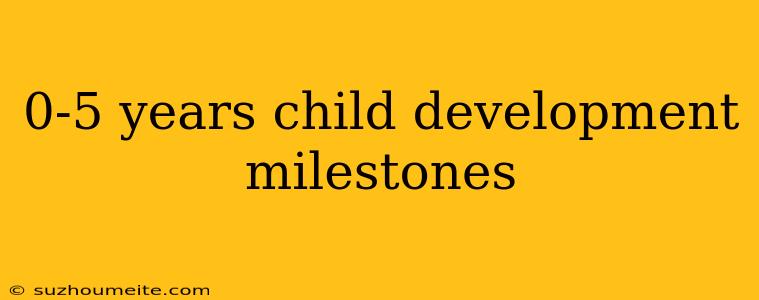0-5 Years Child Development Milestones
Child development is a crucial aspect of a child's growth and lays the foundation for their future success. From birth to five years, children undergo rapid cognitive, social, emotional, and physical development. Tracking these milestones is essential to ensure that your child is on the right path. Here are the significant child development milestones to expect from 0-5 years.
0-1 Year: Infancy
Physical Development
- Lifting head while on stomach (1-2 months)
- Rolling over (2-4 months)
- Reaching and grasping for toys (4-6 months)
- Sitting up with support (6-7 months)
- Sitting up unassisted (7-8 months)
- Crawling (8-10 months)
- Standing with support (9-12 months)
- Standing alone (12 months)
Language and Communication
- Crying to communicate (0-3 months)
- Responding to sounds and voices (2-4 months)
- Babbling and making vowel sounds (4-6 months)
- Saying first words like "mama" or "dada" (6-9 months)
- Imitating sounds and words (9-12 months)
Cognitive Development
- Recognizing familiar faces and objects (0-3 months)
- Tracking moving objects (2-4 months)
- Understanding simple games like peek-a-boo (4-6 months)
- Imitating gestures like waving goodbye (6-9 months)
- Playing with toys and exploring objects (9-12 months)
1-2 Years: Toddlerhood
Physical Development
- Walking independently (12-14 months)
- Pointing to body parts when asked (12-18 months)
- Building towers with blocks (12-18 months)
- Dressing and undressing themselves (18-24 months)
- Using utensils like spoons (18-24 months)
Language and Communication
- Saying 5-10 words to communicate (12-18 months)
- Combining two words together (18-24 months)
- Following simple instructions (18-24 months)
- Identifying body parts when asked (18-24 months)
Cognitive Development
- Imitating actions like clapping and waving (12-18 months)
- Understanding object permanence (12-18 months)
- Showing interest in books and reading (12-18 months)
- Demonstrating problem-solving skills (18-24 months)
2-3 Years: Early Childhood
Physical Development
- Running independently (18-24 months)
- Climbing up stairs with support (18-24 months)
- Kicking a ball forward (21-27 months)
- Drawing simple shapes and scribbles (24-30 months)
- Dressing themselves, including zippers and buttons (27-36 months)
Language and Communication
- Using around 50-100 words to communicate (18-24 months)
- Combining three words together (24-30 months)
- Identifying pictures and objects when named (24-30 months)
- Engaging in simple conversations (27-36 months)
Cognitive Development
- Demonstrating an understanding of cause-and-effect relationships (18-24 months)
- Showing an interest in puzzles and problem-solving (21-27 months)
- Imitating daily activities like cooking and cleaning (24-30 months)
- Counting up to three objects (27-36 months)
3-5 Years: Preschool Age
Physical Development
- Riding a tricycle (30-36 months)
- Hopping on one foot (36-48 months)
- Drawing simple shapes and objects (36-48 months)
- Using scissors to cut straight lines (36-48 months)
- Dressing themselves independently (42-60 months)
Language and Communication
- Using around 1000-1500 words to communicate (30-36 months)
- Engaging in conversations using short sentences (36-48 months)
- Identifying and naming basic shapes and colors (36-48 months)
- Understanding and following simple stories (42-60 months)
Cognitive Development
- Demonstrating an understanding of basic concepts like "in" and "out" (30-36 months)
- Showing an interest in counting and basic math (36-48 months)
- Solving simple puzzles and problems (36-48 months)
- Engaging in imaginative play with others (42-60 months)
Remember, every child develops at their own pace, and some may need more time to master certain skills. If you have concerns about your child's development, consult with your pediatrician or a qualified healthcare professional.
